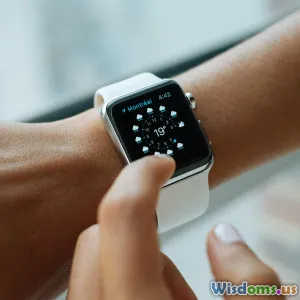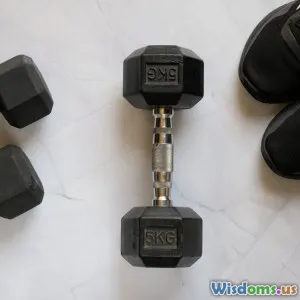Five Wearable Innovations Changing Group Fitness This Year
12 min read Explore five groundbreaking wearable tech innovations transforming group fitness experiences, efficiency, and engagement for 2024. (0 Reviews)Five Wearable Innovations Changing Group Fitness This Year
In studios and parks around the world, group fitness has become more interactive, data-driven, and social than ever before. As connectivity and wearable technology evolve, they are redefining how we move together, motivate each other, and measure success. From biometric trackers and VR headsets to AI-powered coaching, wearables in 2024 are enhancing not just individual performance but also the collective group fitness experience. Here’s a deep dive into five breakthrough wearables revolutionizing group workouts, with actionable insights on maximizing their benefits.
Real-Time Biometric Trackers: From Pulse to Performance
Gone are the days when heart rate monitors consisted of chest straps and basic watch displays. Modern biometric trackers like the Whoop 4.0, Polar Verity Sense, and the Apple Watch Series 9 have become ultra-compact, precise, and team-oriented. Today, studios such as Orangetheory Fitness and F45 leverage these trackers to offer live biometric feedback during sessions—projecting stats like heart rate, calories, and "effort zones" onto communal screens.
How It Works: Participants strap on sensors or wear wristbands before class. The wearables sync to a collective dashboard, often via Bluetooth or Wi-Fi. Instructors and group members see real-time data for each participant, reshaping motivation into a dynamic, visible competition.
Impact on Group Dynamics:
- Social Accountability: When your heart rate and effort are on display, everyone feels more motivated to push harder and stay engaged.
- Gamification: Points, rewards, and team challenges keep things engaging and help weaker members catch up.
- Personalization at Scale: Instructors can deliver targeted suggestions, from recommending smarter recovery to giving high-fives for hitting personal bests.
Pro Tip: Set class-wide goals ("Let’s all hit 90% of our max heart rate at least three times!") or create friendly competition brackets. Remember to choose devices that are comfortable, durable, and with battery life to match your workout schedule.
Smart Connected Fitness Apparel

Yoga pants and compression shirts have gotten smarter. Early wearable apparel embedded sensors to track posture or steps; now, advanced products like Nadi X yoga leggings and Hexoskin smart shirts directly measure muscle activation, respiration, and fatigue in group settings. Lumo Run shorts, for runners, analyze optimal stride, pelvic rotation, and coach runners with real-time audio prompts.
Features to Look For:
- Seamless Sensors: Flexible conductive fibers and micro-sensors woven into cloth, so wearables are virtually invisible and non-restrictive.
- Instant Feedback: Audio, haptic (vibration), or light cues guide posture corrections or breathing during live classes.
- Group Integration: Syncing data to group apps (like SmartSpot or Hykso for boxers) allows teams to benchmark improvements and spot collective trends, such as muscle imbalances or habitual form breakdowns.
Example: At StretchLab, instructors now use smart leggings with synced tablets to highlight group-wide mobility issues. Instructors spot when most members round their backs during forward bends, and offer quick corrections based on synchronous data.
How-to Tip: Wash smart clothing according to manufacturer’s instructions—typically cold water and no dryer. Many products feature detachable sensors or transmitter pods. Keep an eye on battery and software updates for seamless sessions.
Group Fitness Meets Virtual—and Augmented—Reality

VR and AR were technological novelties a few years ago. In 2024, devices like Meta Quest 3 and Zeekr AR Fitness Glasses deliver communal workouts where fun, presence, and interactivity soar to new heights. Gyms are embracing VR spinning, group HIIT in virtual stadiums, and augmented collaborative yoga, making fitness classes both accessible and immersive.
Platforms & Experiences:
- Supernatural and FitXR: Members join instructor-led classes inside immersive environments (boxing in neon-lit arenas or stretching on mountaintops), all while avatars and voice chat foster real-time companionship.
- Les Mills XR: Maltese gyms piloting classes issue AR glasses to each participant. Cues and virtual guides float in field of view, offering form tips, pace reminders, and encouragement from coaches—even when the instructor is across the world.
Benefits:
- Accessibility: Everyone from corporate employees to homebodies can join the same class simultaneously, regardless of location.
- Increased Engagement: Dynamic environments and avatars gamify classes, defusing social shyness and making exercise feel like play.
- Real-Time Coaching: AR overlays highlight misalignments and suggest corrections, even in large classes where one coach can’t watch everyone.
Practical Insight: VR/AR headsets are getting lighter but can heat up. Schedule hydration breaks, and rotate activities to avoid fatigue or eye strain. Look for perks like built-in heart rate sensors, or platforms offering "family accounts" for group scheduling.
AI-Powered Group Coaching and Insights

Artificial intelligence is bridging trainers’ knowledge with participants' real-time needs. New AI-coaching wearables, such as the Amazfit Helio Ring and Google’s Fitbit Sense 3 (now boasting on-device ML), perform comprehensive analyses of group biometric data. They spot shared trends—such as collective dips in recovery, hydration needs, or optimal time slots for group performance—and suggest coaching interventions on the fly.
How It Works: Sensors gather vast datasets: heart rate variability, sleep, movement efficiency, and stress. Custom AI algorithms crunch numbers across an entire group and surface patterns, like common fatigue days, optimal warm-up protocols, or even who might benefit from lighter intensity workouts.
Actionable Uses:
- Scheduling Optimization: AI learns when your group has the highest collective readiness, suggesting the ideal days and times for the toughest workouts.
- Custom Recovery Plans: After a heavy group session, the system can recommend tailored cooldowns, group stretches, or hydration reminders, all based on shared biometric readouts.
- Live Coach Assist: Instructors receive cues ("Section B’s temperature rising abnormally—check airflow!") or suggested rest breaks to pre-empt fatigue or illness across the team.
Tip for Teams: Invest in platforms that support data privacy and transparency. Look for apps that allow teams to opt-in, set boundaries, and anonymize sensitive data. This cultivates trust without sacrificing personalized group progress.
Social Wearable Devices: Encouragement Through Connection

Perhaps the most transformative innovation is the evolution of wearables from solo motivators to true social connectors. Devices like Garmin Venu 3, Oura Ring’s family plan, and the Myzone MZ-Switch lead the charge by enabling groups to share goals, send mid-workout encouragement, and track progress collectively.
Features Redefining Group Support:
- Instant Kudos and Alerts: Friends send “fist bumps” or encouragement straight to your device, via haptic buzz or on-screen messages, during a tough rep or team relay.
- Progress Sharing & Group Badges: Collaborative streaks, earned group badges, and “keep the chain alive” functions nurture accountability—even across different cities or time zones.
- Wellness Communities: Integration with social messaging means teams form micro-communities, supporting not just fitness, but mental health, nutrition, and sleep goals.
Example in Practice: A CrossFit cohort uses Myzone’s app to visualize everyone’s effort rate during AMRAPs, celebrate milestones instantly, and share actionable recaps. The group chats drive engagement higher, and studies indicate workouts performed with visible encouragement can elevate participant output by up to 19%.
Actionable Advice: Choose a platform with robust privacy settings and cross-platform compatibility, so no teammate is left out due to brand loyalty. Consider setting up group challenges—kilometers tallied, days streaked, minutes in heart zone—and reward group loyalty!
Looking Ahead: The Future of Connected Fitness
Wearable innovations are no longer novelty or accessory—they’re integral to the group fitness landscape. As these five technologies become mainstream, group training is set to become even more inclusive, competitive, and data-rich. No matter your role—athlete, coach, class leader, or casual participant—embracing these devices offers a pathway to deeper community, smarter workouts, and, importantly, more fun. Keep exploring the evolving ecosystem, and the collective potential of your fitness tribe will only grow stronger.
Rate the Post
User Reviews
Popular Posts
















